817 Search Results for praactical teaching
May 11, 2015
by Carole Zangari -
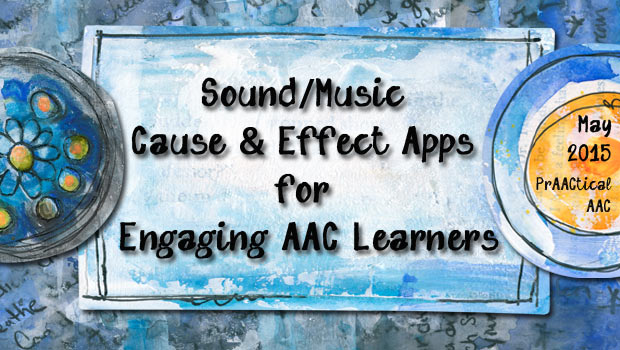
AAC clinicians are a creative bunch. Recently, I had the opportunity to visit some colleagues and was excited to see how they are repurposing free/low cost apps to build engagement and interaction in learners with significant communication challenges. Many of us work with learners who are highly motivated by mobile devices and apps that make music or sound, but still have a way to go to build their skills in using them. For some, we find that using apps that are relatively simple and easy (both motorically and cognitively), can spice up a session. Here are some sound/music cause and effect apps to explore. Of course, these apps are intended for a purpose completely different than how we are using them in therapy. Nonetheless, kids love them and that means that we SLPs can get a lot of mileage out of using apps like these in our therapy sessions. Burp... [Read More...]
May 5, 2015
by Carole Zangari -
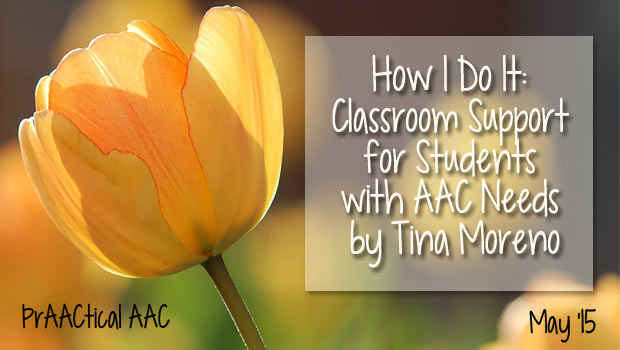
We are fortunate to have a return visit from Tina Moreno, who brings her experiences both as an SLP and also as a mom of a teenager who has used AAC for most of his life. In this post, Tina shares some of the strategies that she has used to support AAC students in their classrooms. If you are a school-based SLP, don’t miss Tina’s classroom observation form for gathering data on how AAC is being used in various activities and lessons. GIVE THEM FIVE As an SLP in the school setting, helping teachers support students in the classroom can be a big challenge. While we can see students making progress in our therapy sessions, it can be difficult to get the same results in the classroom. An important role of the SLP is to collaborate with teachers to help students generalize these skills in conversation with their peers and other... [Read More...]
April 30, 2015
by Carole Zangari -
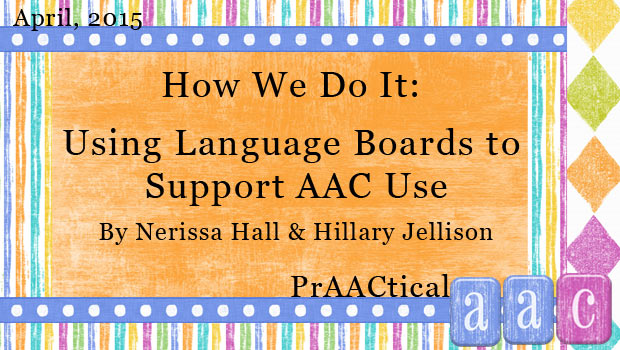
Many of you have reached out to say how much you’ve appreciated the prAACtical suggestions provided by Nerissa Hall and Hillary Jellison, New England-based SLPs and owners of Commūnicāre, LLC. We’re excited to have them back, especially because they are talking about something near and dear to our hearts: Implement a core vocabulary approach in their AAC therapy. In this post, they give us a peek into the ‘why’ and ‘how’ of making and using communication boards that are rich in core words. In their typically generous fashion, they also share templates for the boards that they make. How We Do It: Using Language Boards to Support AAC Use There are a number of different strategies one can use to support an individual’s use of augmentative and alternative communication (AAC). We know that aided language stimulation, augmented input, and AAC modeling are important and effective ways of supporting AAC use. By using... [Read More...]
March 26, 2015
by Carole Zangari -
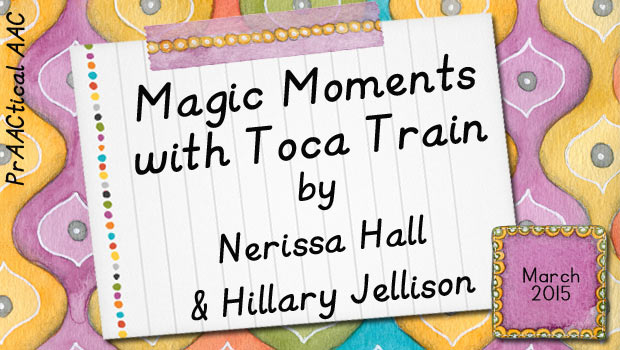
Many of us have worked with learners who have a special interest in trains, but even kids who don’t give trains more than a passing glance still generally love the Toca Train app by Toca Boca. In this post, we welcome back SLPs Nerissa Hall and Hillary Jellison of Communicare, LLC who share how they use Toca Train in their clinical work with young AAC learners. In addition to their prAACtical suggestions, they generously share a train-themed communication board and their data sheet for the phrases that can be targeted in this activity. iPad applications are fun and engaging, and can be a great addition to any clinician’s intervention toolkit. We use iPad applications to engage our learners in play-based activities that address a range of speech, language, and communication goals. One of our learners’ favorite applications is Toca Train; a bright and colorful application that involves a train moving around a track at different speeds, controlled... [Read More...]
March 23, 2015
by Carole Zangari -
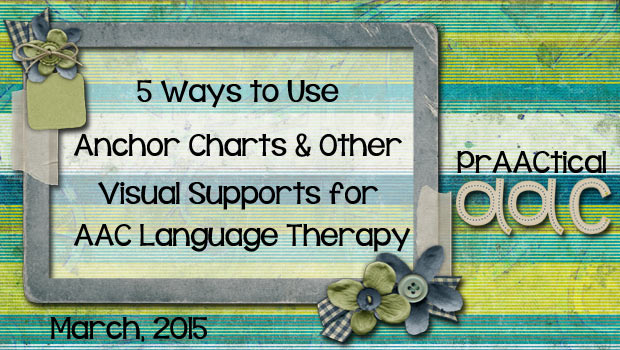
Anchor charts are a visual way to outline, describe, or illustrate a procedure, strategy, or concept. They are widely used visual supports in general education classrooms across the grade levels. In AAC therapy, anchor charts offer several benefits. First, making the anchor chart forces us to distill the main ideas in whatever it is we are teaching. What are the key aspects of what we are teaching? We have to answer that to create our anchor chart, and that gets us really thinking about the concept/process/strategy in great detail. Selecting the critical elements for our anchor chart helps us focus on the constructs that are most important to teach. Secondly, it helps us explain the concept/process/strategy in a more concise and articulate way. Putting things into writing forces us to clarify our explanations, and allows us to carefully consider what to say and how to say it. Yes, we sometimes... [Read More...]
March 16, 2015
by Carole Zangari -
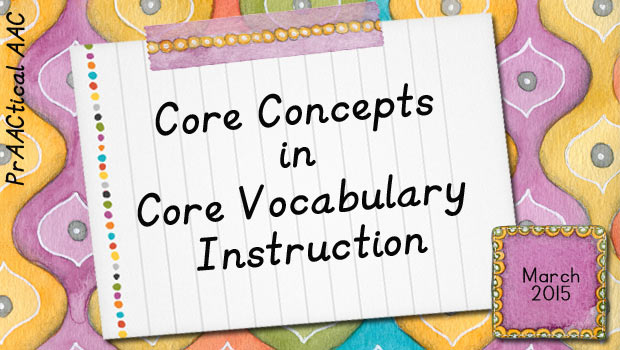
We’ve been talking about implementing A Year of Core Words and A(nother) Year of Core Words for our March words. If you are new to the idea, it involves highlighting a different set of set of 12-16 core words each month to help our AAC learners get progressively more familiar with their vocabulary options. Today, we’re linking to some posts with ideas for what to do with the core words for each month. Laying the Foundation Give learners access to core vocabulary in their communication books, SGDs, and/or AAC apps. Prepare the core vocabulary materials for the month. If you haven’t started, don’t sweat it. Just download, print, and give it a go. “A year from now, you will wish you had started today” (K. Lamb). We are ALL a work in progress. Use the core words in an AAC system when you speak. Whether we call it aided language... [Read More...]
March 5, 2015
by Carole Zangari -
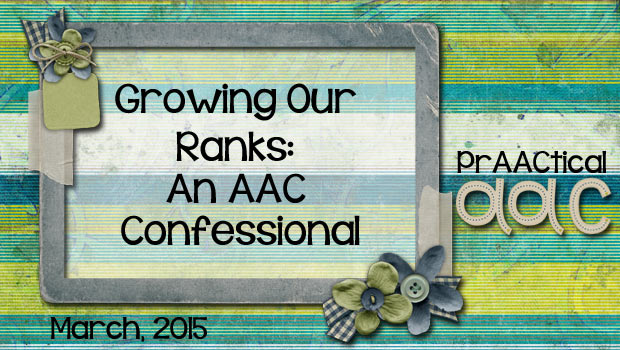
It’s funny where life takes you. A former student of mine was unhappy as an attorney, but found deep satisfaction in becoming an SLP. Another one enjoyed her work as an SLP, but reached even more lives by founding a company for low tech communication and literacy materials. As SLP students, we might not have considered the role that people with AAC needs would play on our caseloads. And with over 90% of school-based SLPs serving kids with autism, my guess is that many who are now supporting nonverbal or minimally verbal students had no intention of specializing in AAC. And yet, there they are: a language lifeline for students who cannot communicate effectively through speech. I am so grateful to today’s guest author, Sara Barnhill, for sharing her own experience in becoming an AAC service provider. Sara is an SLP who has has worked at Children’s Hospital of Richmond at... [Read More...]
March 3, 2015
by Carole Zangari -
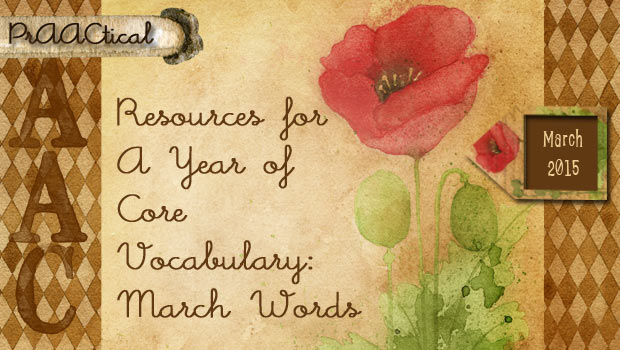
Our list of resources is growing! Let’s add a few more resources courtesy of SLPs Alison Wade and Heidi LoStracco. We’ve uploaded some additional printables for the Year of Core words (2013 list with 12 words per month)represented in PCS, Symbol Stix, and Smarty Symbols. Thanks, Alison, Heidi, and all who contributed to this effort! Templates for you to plug in your own symbols: 2013 words, 2014 words Minspeak/Unity version: 2013 PCS versions: 2013; 2014 Speak for Yourself version: 2013, 2014 Symbol Stix version: 2013 Use these materials to remind yourself which words to highlight this month, with using aided language input and focused language stimulation. What else? Print them and hang them on a bulletin board or refrigerator. Laminate, cut them apart, and put them on a binder ring that you keep handy so that you can show just one symbol at a time. Use them to create... [Read More...]
February 26, 2015
by Carole Zangari -
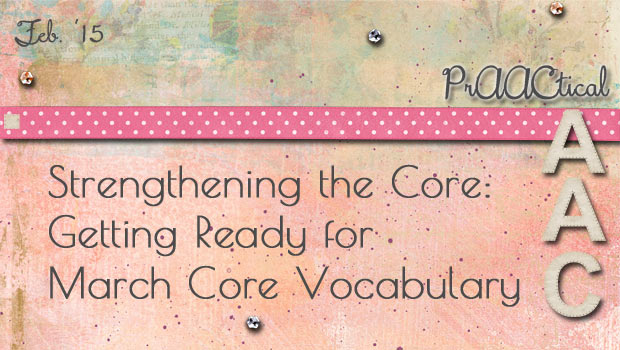
March is around the corner, so if you are following along our 2013 Year of Core (12 words/month) or the 2014 A(nother) Year of Core (16 words/month; Different than the previous year’s core words), it is time to get ready to focus on a new set of words. “Wait! My clients/students didn’t master the January or February words. Should I really go on?” Yes, you probably should! Every situation is different, of course, but for the vast majority it makes sense to move on. Sticking with the same set of words is likely to bore you and frustrate the kids. With a core word approach, it’s about progress, not perfection. We aren’t giving up on the prior words. In fact, we will continue to model them (with aided language input) and create opportunities for our learners to use them, providing supports, as needed). At the same time, we’re expanding our focus to... [Read More...]
February 19, 2015
by Carole Zangari -
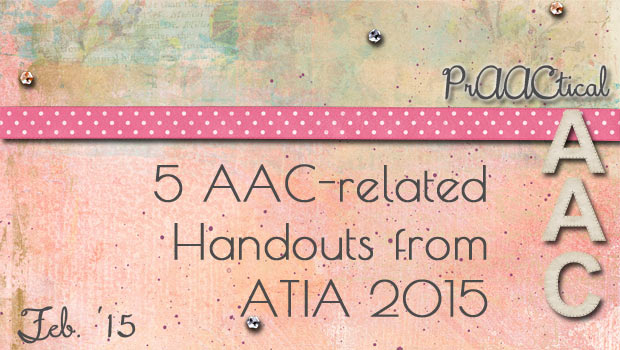
The 2015 ATIA conferences was one of the strongest in recent memory, with lots of AAC presentations to choose from. As you can see, I had a blast! There was AAC in every direction, from the Town Hall Meetings, App Smackdowns, expanded poster sessions, traditional sessions, and, of course, the exhibit hall. If professional development in AAC is a priority for you, be sure to put the 2016 conference (in Orlando) on your radar for February 2-6, 2016. In the meantime, here are some of the handouts to whet your appetite. Lori Wise and Marlene Sotelo’s terrific talk on using iPads to build social engagement with people who have ASD along with their app lists here and here was one of my favorite presentations of the conference. [Note: Their handouts are hosted on the ATIA conference site and may only be available for a limited time. Grab them while you can!] Gretchen... [Read More...]









